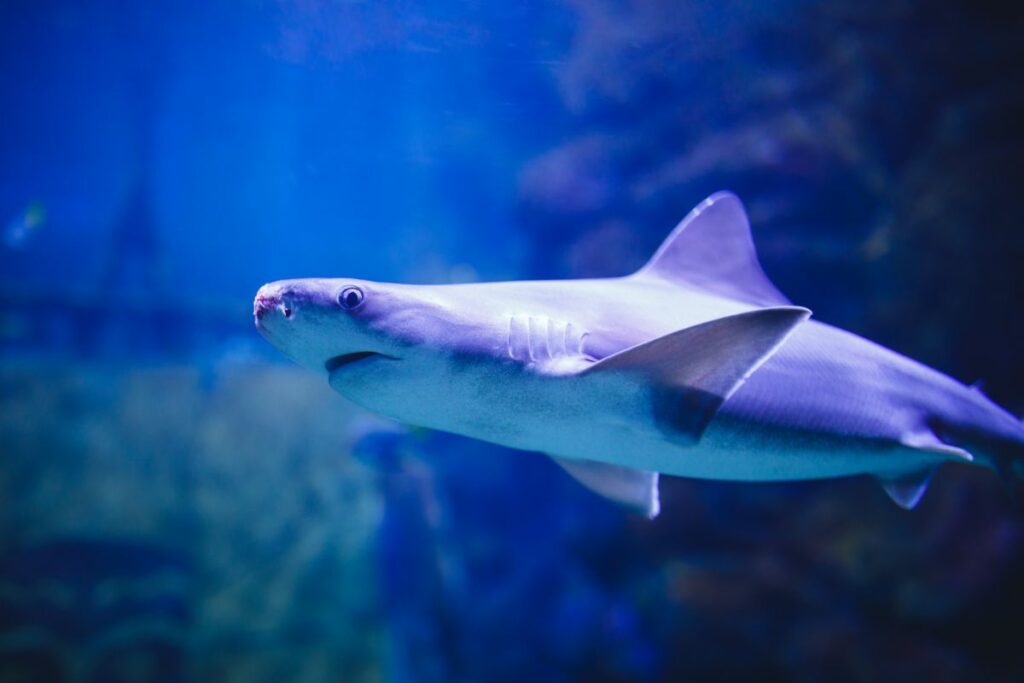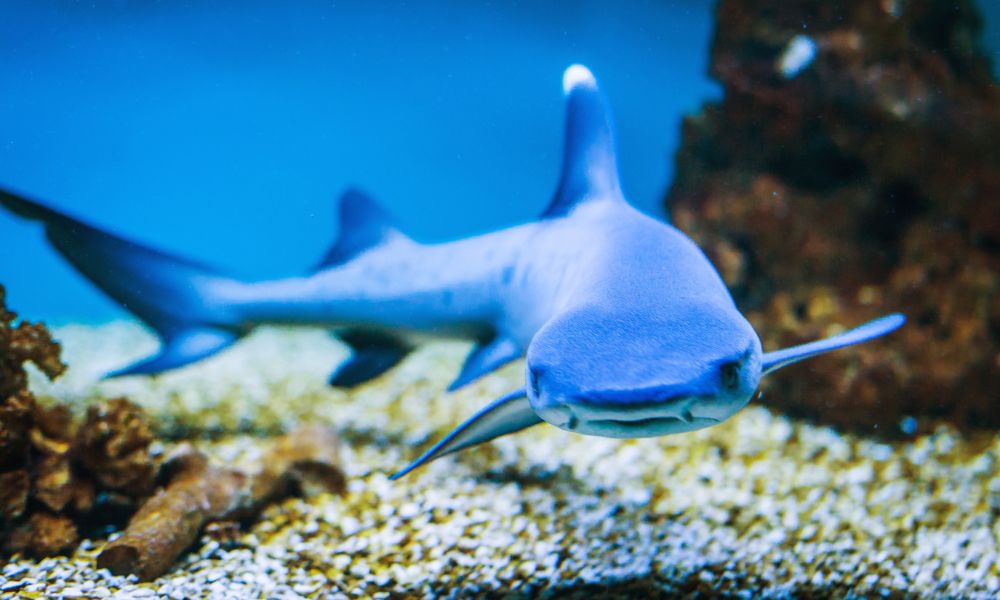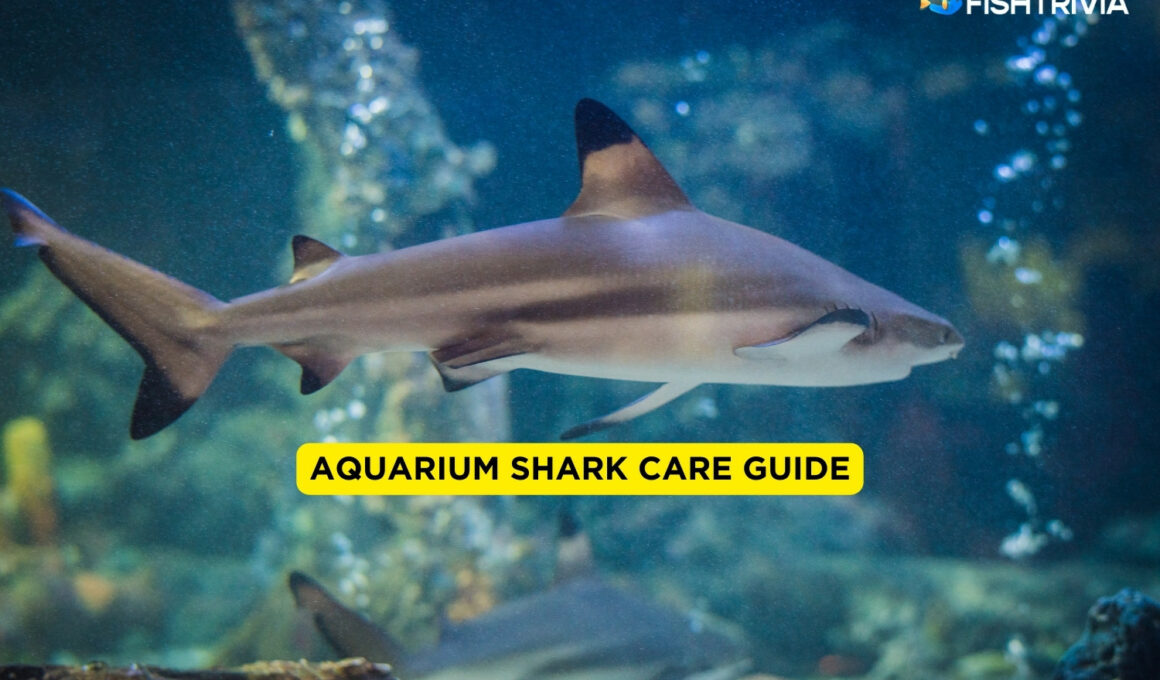In this article Show
I’ve had my fair share of experience with various aquatic pets, from the tiniest tetras to these fascinating creatures of the deep. But let’s set things straight: while these elegant swimmers are a marvel to observe, they’re not just another fish to add to your tank.
They come with their unique set of requirements and responsibilities. Many dive into the idea of having sharks at home, picturing “Jaws” in a fishbowl, but that’s far from reality.
It’s easy to be drawn in by their beauty and intrigue, but remember that every shark fin you see skimming the surface of an aquarium represents a commitment. A commitment to the proper care, environment, and diet these animals deserve.
Throughout this guide, we’ll debunk some myths, share pro tips, and ensure that if you decide to embark on this journey, you’re well-equipped with knowledge. Whether you’re just curious or seriously considering adding a shark to your underwater family, I’m here to guide you through.

Types of Aquarium Sharks
Before we delve into the ins and outs of setting up a tank or diving into dietary requirements, it’s pivotal to familiarize yourself with the various types of sharks suitable for home aquariums.
Not all sharks are created equal, especially when it comes to tank living. So, here’s a rundown on some of the most popular species, each with its own unique quirks and care needs.
1. Saltwater Sharks
Bamboo Sharks
These are perhaps one of the most popular choices for home aquarists. Small in size, with a maximum length of about 3 feet, Bamboo Sharks are bottom dwellers with a docile temperament. They come in different varieties like the Brownbanded Bamboo Shark and the White-spotted Bamboo Shark.
Banded Cat Sharks
Known for their stunning striped pattern, these nocturnal creatures tend to stay on the smaller side, maxing out at around 3 feet. They love to lounge around and require plenty of hiding spots.
Epaulette Sharks
Recognizable by the large spots above their pectoral fins that resemble military epaulettes, these sharks are another favorite. They’re hardy, adaptable, and are known for their ability to “walk” on their fins, making them quite the showstopper!
2. Freshwater Sharks
Silver Sharks (Bala Sharks)
Hold on! While commonly referred to as sharks due to their dorsal fin’s resemblance, they’re not real sharks. They’re actually a type of minnow. Growing up to a foot long, these active swimmers need spacious tanks and prefer being in groups.
Red-tailed Black Sharks
Another freshwater misnomer, these “sharks” are actually part of the carp family. With their striking black bodies and contrasting red tails, they can be territorial but make a vivid addition to large aquariums.
Rainbow Sharks
Sporting a slender body and fierce territorial instincts, the Rainbow Shark boasts an eye-catching vibrant red fin against a dark body. They thrive best with ample hiding spots and a sizable tank to stake their claim.
Choosing the right shark is paramount. While they all share the moniker of “shark,” their individual requirements can be as diverse as the oceans and rivers they hail from.
Always remember to consider the adult size of the species, not just the cute little shark you see at the pet store. That small shark can grow – and so should your preparations and commitment!
Tank Setup and Environment
Now that we’ve familiarized ourselves with the types of sharks you might be considering, it’s time to talk about their living spaces. Ensuring a proper environment is paramount for the health and well-being of any aquatic life, and sharks are no exception. Here’s what you need to know:
1. Tank Size and Dimensions
Think of the tank as their universe. Especially for creatures as grand as sharks, cramped spaces are a big no-no. The rule of thumb is simple: the bigger, the better. This ensures they have room to swim, grow, and express natural behaviors.
It’s easy to be misled by that adorable, palm-sized shark at the store. However, remember they grow – and some species grow a lot.
Always consider their potential adult size. For instance, Bamboo and Banded Cat Sharks require tanks of at least 180 gallons, but the larger the tank, the happier your shark will be.
2. Water Quality and Parameters
Salinity
For saltwater sharks, maintaining the right salinity is pivotal. This typically falls between 1.020 and 1.025 specific gravity. Freshwater “sharks” don’t have this concern but do pay heed to water hardness and mineral content.
pH, Temperature, and Hardness
Each species has its preference, but generally, a pH of 8.1 to 8.4 and temperatures between 72°F to 82°F are ideal for saltwater sharks. Freshwater counterparts prefer slightly acidic to neutral pH and similar temperature ranges.
Filtration
Sharks, like all fish, produce waste. A strong filtration system that can handle the load and ensure water turnover is vital. You might want to invest in both mechanical and biological filtration for optimal water clarity and cleanliness.

3. Decor and Enrichment
Substrate
Opt for soft, sandy substrates, especially for bottom-dwelling species. This prevents injuries and mimics their natural habitat.
Hiding Spots
Caves, overhangs, and other hideouts aren’t just for aesthetics. They provide shelter and a sense of security for your shark. PVC pipes can also be a cost-effective and safe hiding spot.
Tankmates and Compatibility
Sharks are generally peaceful, but remember, they are still top predators. Some species might be more aggressive or territorial. Research compatible species and avoid cramping too many fish in a tank, which could lead to territorial disputes.
Diet and Feeding
Alright, let’s get to the juicy bits – quite literally! Beyond the ambiance of their living quarters, what you feed your sharks plays a pivotal role in their overall health and well-being. So, let’s talk about that shark appetite and how best to satiate it.
1. Nutritional Needs
Just like us, sharks thrive on a varied diet. Repetition can be boring, and more importantly, it can miss out on key nutrients. By rotating their food, you ensure they get a balanced intake of vitamins, minerals, and essential fatty acids.
Remember, many sharks are carnivores. Their diet in the wild consists of smaller fish, crustaceans, and sometimes even mollusks. Emulating this natural diet ensures they get the right nutrients in captivity.
2. Recommended Foods
- Commercial Foods: There are high-quality pellet foods available specifically formulated for sharks. These can be a staple in their diet, offering balanced nutrition.
- Live and Frozen Foods: Treat your sharks with live foods like shrimp, small fish, or crabs occasionally. Alternatively, frozen options like squid, krill, or fish fillets are great. Just ensure they’re properly thawed before feeding
- Supplements: Consider adding vitamin and mineral supplements, especially if you’re relying heavily on a commercial diet. This ensures they’re not missing out on any essentials.
3. Feeding Tips
- Portion Control: Overfeeding isn’t doing any favors. It can pollute the water and harm your shark’s health. Typically, feed only what they can consume in 5 minutes. Watch their behavior and adjust accordingly.
- Feeding Frequency: This varies with the species and age. Younger sharks might eat daily, while adults can be fed 2-3 times a week. Always monitor and adapt to their needs.
- Tools: Some aquarists use feeding sticks or tongs to offer food. This can help control portions and ensure food reaches the intended shark, especially in a community tank.
Lifespan and Health
Navigating further into our deep dive, it’s crucial to address the longevity and health of these captivating creatures. Knowing what to expect and how to ensure optimal health can make a world of difference in your shark-keeping journey. So, let’s swim into the details!
1. Lifespan
Sharks, in general, have an impressive lifespan. In a well-maintained home aquarium, many species can live for several years. For instance, Bamboo Sharks can live up to 25 years, while Banded Cat Sharks might grace your tank for 20 years or more. It’s a commitment!

While genetics play a part, external factors like diet, tank conditions, and overall care significantly influence their longevity. A stress-free environment and balanced nutrition can maximize their lifespan.
2. Common Health Issues
Stress
A stressed shark is a susceptible shark. Signs of stress include erratic swimming, refusal to eat, or staying hidden for extended periods. Causes can range from poor water conditions, inadequate space, to incompatible tank mates.
Skin and Fin Issues
Just like other fish, sharks can suffer from parasites, fungal infections, or injuries. Look out for discoloration, visible parasites, or tattered fins. Proper water conditions and routine checks can prevent many of these issues.
Digestive Problems
Overfeeding or feeding low-quality foods can lead to digestive problems. Ensure your shark eats a balanced diet and monitor its excretion to ensure everything’s running smoothly.
3. Prevention and Care
- Quarantine: Before introducing a new shark (or any fish) to your main tank, it’s wise to quarantine them. This can help identify any health issues and prevent potential spread.
- Regular Checkups: Make it a habit to observe your sharks daily. Familiarizing yourself with their usual behavior will help you spot anomalies quickly, should they arise.
- Water Quality: We can’t stress this enough! Most health issues can be avoided by maintaining optimal water conditions. Regular water testing and changes are your best defense against potential problems.
Breeding and Conservation
While breeding sharks in a home setting can be an exhilarating challenge, understanding their broader place in the ecosystem and our role in their preservation is equally vital. Let’s embark on this enlightening journey.
1. Breeding In Captivity
Shark breeding isn’t for the faint of heart. It requires keen observation, patience, and sometimes, a bit of luck. Not all shark species breed easily in captivity.
Mating Signs
Depending on the species, sharks might display specific behaviors when ready to mate, such as nuzzling or following closely. Recognizing these signs is the first step.
Nesting Grounds
Some species, like the Bamboo Shark, lay eggs (often called “mermaid purses”). Providing a conducive environment with the right substrate and hiding spots can encourage this behavior.
Offspring Care
Once baby sharks (pups) are born or hatch, they might need separation from larger fish, including their parents, to ensure their safety. Proper nutrition and water conditions are even more vital during these initial stages.
2. Conservation Status
A Global Concern
Many shark species worldwide face threats, with several of them classified as vulnerable or endangered. Overfishing, habitat destruction, and climate change have put significant pressure on their populations.
The Aquarium Trade
While the home aquarium trade isn’t the primary threat to sharks, it still plays a role. Always ensure you’re acquiring sharks from ethical and sustainable sources. Unscrupulous collection can harm wild populations and damage their habitats.
Education and Advocacy
As shark keepers, we’re in a unique position to educate and advocate. By sharing knowledge and showcasing these magnificent creatures, we can play a role in fostering appreciation and conservation efforts.
Frequently Asked Questions
Can I keep a shark in a regular home aquarium?
It depends on what you define as “regular.” While there are smaller shark species suitable for home aquariums, they still require a sizable tank — often starting at 180 gallons or more for adults. Always research the specific requirements of the species you’re interested in and prepare for their adult size, not just their size as juveniles.
How often should I change the water in a shark tank?
Regular water changes are essential for maintaining optimal water quality. Typically, it’s recommended to change 10-20% of the tank water weekly. However, this can vary based on tank size, filtration efficiency, and the number of inhabitants. Regularly testing the water parameters will give you a clearer picture.
What should I do if my shark seems sick?
First, check the water parameters to ensure they’re within the recommended range for your shark species. If everything seems fine but your shark still shows signs of illness, consider quarantining it to prevent potential spread of disease. It’s also advisable to consult with a veterinarian who specializes in aquatic animals.
Is it ethical to keep sharks in captivity?
This question often stirs debate. The key lies in providing an environment that meets the shark’s physical, dietary, and psychological needs.
If you can offer a spacious tank, proper diet, and stimulation, and you source your sharks ethically, it can be done responsibly. However, always prioritize the well-being of the animal and continuously educate yourself to provide the best care possible.






